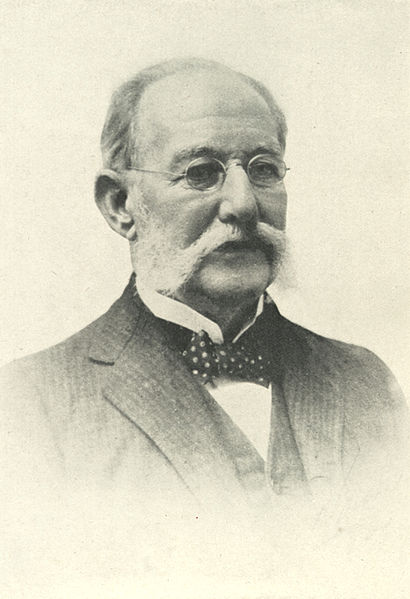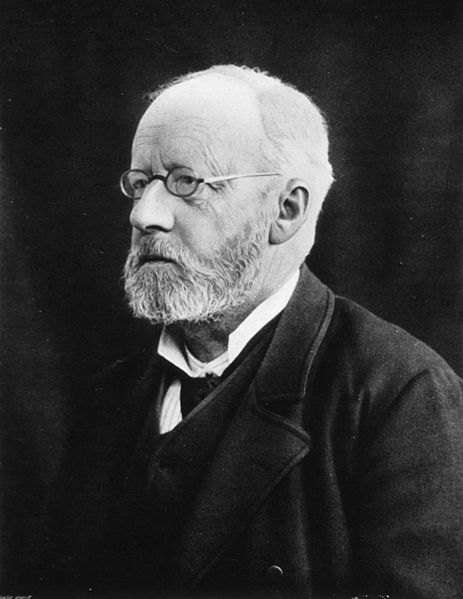<Back to Index>
- Physician Carlos Juan Finlay, 1833
- Pathologist Theodor Albrecht Edwin Klebs, 1834
PAGE SPONSOR

Carlos Juan Finlay (December 3, 1833 – August 20, 1915) was a Cuban physician and scientist recognized as a pioneer in yellow fever research.
Finlay was born Juan Carlos Finlay y Barres, in Puerto Príncipe (now Camagüey), Cuba, of French and Scottish descent. He reversed the order of his given names to "Carlos Juan" later in his life. In 1853 he attended Jefferson Medical College in Philadelphia, Pennsylvania. He graduated in 1855, and completed his studies in Havana and in Paris. Afterwards he settled in Havana and opened a medical practice.
Finlay's work, carried out during the 1870s, finally came to prominence in 1900. He was the first to theorize, in 1881, that a mosquito was a carrier, now known as a disease vector, of the organism causing yellow fever: a mosquito that bites a victim of the disease could subsequently bite and thereby infect a healthy person. A year later Finlay identified a mosquito of the genus Aedes as the organism transmitting yellow fever. His theory was followed by the recommendation to control the mosquito population as a way to control the spread of the disease.
His hypothesis and exhaustive proofs were confirmed nearly twenty years later by the Walter Reed Commission of 1900. Finlay went on to become the chief health officer of Cuba from 1902 to 1909. Although Dr. Reed received much of the credit in history books for "beating" yellow fever, Reed himself credited Dr. Finlay with the discovery of the yellow fever vector, and thus how it might be controlled. Dr. Reed often cited Finlay's papers in his own articles and gave him credit for the discovery in his personal correspondence.
In the words of General Leonard Wood, a physician and U.S. military governor of Cuba in 1900: "The confirmation of Dr. Finlay's doctrine is the greatest step forward made in medical science since Jenner's discovery of the vaccination (of smallpox)."
This discovery helped William C. Gorgas reduce the incidence and prevalence of mosquito borne diseases in Panama during the American campaign from 1903 onward to construct the Panama Canal. Prior to this, about 10% of the workforce died each year from malaria and yellow fever.
In the municipality of Marianao, now within the city of Havana, there is a monument honoring Dr. Finlay. This monument has the shape of a syringe and it is usually referred to as El Obelisco (The Obelisk). Finlay was also commemorated on a 1981 Cuban stamp. A statue commemorating Dr. Finlay is located on the bayfront in Panama City, near the canal he helped make possible. The UNESCO Carlos J. Finlay Prize for Microbiology is named in his honor.
Dr. Finlay was a member of Havana's Royal Academy of Medical, Physical and Natural Sciences. He was fluent in French, German, Spanish and English, and could read Latin. His interests were widespread and he wrote articles on subjects as varied as leprosy, cholera, gravity and plant diseases. But his main interest was yellow fever, and he was the author of 40 articles on this disease. His theory that an intermediary host was responsible for the spread of the disease was treated with ridicule for years. A humane man, he often took on patients who could not afford medical care. As a result of his work, Dr. Finlay was nominated seven times for the Nobel Prize in Physiology or Medicine, but it was never awarded to him. He received the National Order of the Legion of Honor of France in 1908.
Finlay died from heart failure caused by pneumonia in his home in Havana, Cuba.

Theodor Albrecht Edwin Klebs (6 February 1834 – 23 October 1913) was a German - Swiss pathologist. He is mainly known for his work on infectious diseases. He is the father of Arnold Klebs.
Klebs was born in Königsberg, Province of Prussia. He studied at the University of Würzburg under Rudolf Virchow in 1855 and received his doctorate at the University of Berlin in 1858. He achieved his habilitation at the University of Königsberg the following year.
Klebs was an assistant to Virchow at the Charité in Berlin from 1861 until 1866, when he became a professor of pathology at the University of Bern in Switzerland. He married Rosa Grossenbacher, a Swiss, and also acquired Swiss citizenship. He served as a military physician for the Prussian Army in 1870 during the Franco - Prussian War; several of his ancestors had fought during the Napoleonic Wars.
Klebs taught at Würzburg from 1872 – 73, at Prague from 1873 – 82, and at Zürich from 1882 – 92. Because of disagreements with the rest of the faculty, the impetuous Klebs resigned from Zürich in 1893 and ran an unsuccessful private business in Karlsruhe and Strassburg in 1894.
From 1896 – 1900 Klebs taught at Rush Medical College in Chicago, United States. From 1905 – 10 he was a private researcher in Berlin, after which he returned to Switzerland, living with his oldest son in Lausanne. Klebs died in Bern.
In 1883 Klebs successfully identified the bacterium Corynebacterium diphtheriae as the etiological cause of diphtheria. This bacterium is also known as the Klebs - Löffler bacillus.
The bacterial genus Klebsiella is named in honor of his work.